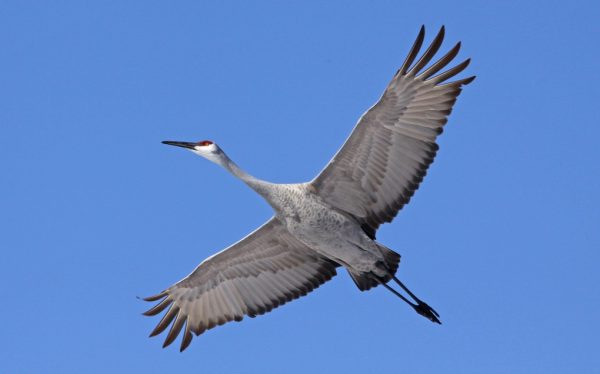
A sandhill crane takes flight. Tom Hodgson | Washtenaw Voice
By Catherine Engstrom-Hadley
Staff Writer
Every year in Michigan, a migration of thousands of Sandhill cranes takes place in the lower peninsula. People travel from all over to catch a glimpse of these ancient-looking birds in Washtenaw and Jackson counties, before the birds take off to the Southern parts of the United States.
Sandhill cranes can be up to five feet tall, are known for their long necks and a six-foot wingspan, and have grey and white bodies with bright red painted heads. Sandhill cranes are thought to look rather prehistoric, and there is a reason for that.
“They are one of the living oldest species left unchanged, it’s been nine million years since there’s been any physical change to these birds,” said Lindsay Cain, the Education Coordinator for Michigan Audubon. In the 1930’s, Michigan only had 16 mating pairs of Sandhill cranes due to habitat destruction. “Sandhill cranes have had really successful conservation recovery in terms of getting population numbers back up to what they should be,” said Cain. Annual counts are done all over Michigan to make sure these numbers stay around 50 thousand.
Sandhill cranes spend October and early November in Michigan marshlands. The cranes eat a little bit of everything: “Grain, insects, small lizards, they are unique in that they are omnivores,” Cain said.
- Cranes in Fall ploomage. Tom Hodgson | Washtenaw Voice
- Adult crane with hatchling in nest. Tom Hodgson | Washtenaw Voice
- Crane landing formation. Tom Hodgson | Washtenaw Voice
- Nesting in Big Portage Marsh. Tom Hodgson | Washtenaw Voice
- Cranes in fallow field searching for food. Tom Hodgson | Washtenaw Voice
- Crane watchers on the hilltop. Tom Hodgson | Washtenaw Voice
- Two cranes dancing. Tom Hodgson | Washtenaw Voice
- A family group. Tom Hodgson | Washtenaw Voice
- Three cranes in a field. Tom Hodgson | Washtenaw Voice
- Rattling bugle call. Tom Hodgson | Washtenaw Voice
The cranes spend their time in Michigan fattening up for the next leg of migration, which varies depending on the subspecies of crane. Most of the cranes head south to Florida, Texas, Nebraska, and Utah.
If you want to see a Sandhill crane, all you might need is a pair of binoculars “You don’t want to get to close to the cranes, they are coming in to be safe for the night, so binoculars help if you have them, but they are big birds so you should be able to see them,” said Cain.
The Sandhill cranes roost in marshes and land in the early evening, usually after 5 p.m. The Haehnle Audubon Sanctuary in Jackson County is the largest roosting area for the cranes. When water levels are right, you can expect up to eight thousand cranes to be spotted. Kensington Metropark, the Koenn preserve, and Waterloo Recreation Area are all great places to view some of these dinosaur-like birds in action. For more information on sandhill cranes and how to find them, visit michiganaudubon.org.












